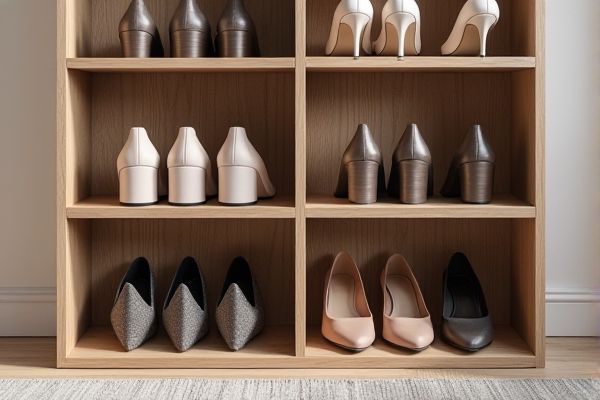
Choosing between a high-heel rack and a flat shoe rack depends on your shoe collection's needs and available space, as high-heel racks are designed to securely hold heels upright, preventing damage and saving room, while flat shoe racks accommodate a variety of footwear but may not offer as specialized support. Explore the differences in design, functionality, and storage benefits to find the perfect solution for your shoe organization by reading the full article.
Table of Comparison
| Feature | High-Heel Rack | Flat Shoe Rack |
|---|---|---|
| Design | Vertical slots or angled holders for heels | Horizontal shelves or cubbies for flats |
| Shoe Type | High heels, stilettos, pumps | Flats, sneakers, sandals, loafers |
| Space Efficiency | Compact, maximizes vertical space | Can take up more floor space |
| Capacity | Holds multiple pairs securely | Varies by size; holds more flat shoes |
| Protection | Prevents heel damage and deformation | Protects shoe shape, less focused on heels |
| Accessibility | Easy to view and grab heels | Easy stacking, but may need rearranging |
| Best For | High heel enthusiasts, fashion-focused users | Everyday flats, casual shoe storage |
Introduction to High-Heel and Flat Shoe Racks
High-heel racks are specifically designed to accommodate the unique shape of high-heeled shoes, featuring angled slots or tapered compartments that prevent heels from bending or damage, offering optimal storage for your collection. Flat shoe racks, by contrast, provide broader, level surfaces ideal for sneakers, flats, or sandals, maximizing space efficiency and ease of access. Choosing the right rack depends on your shoe type and storage needs, ensuring your footwear remains organized and well-preserved.
Design Differences: High-Heel vs Flat Shoe Racks
High-heel racks feature angled or tiered slots specifically designed to accommodate the elevated heels and narrow soles, ensuring shoes maintain their shape and balance. Flat shoe racks typically have horizontal shelves or cubbies that provide ample surface area for storing various shoe types without causing deformation. The structural design of high-heel racks prioritizes stability for elevated footwear, whereas flat racks emphasize capacity and versatility for sneakers, flats, and other flat-soled shoes.
Material Comparisons
High-heel racks are typically made from sturdy metals like steel or thicker wood to support the uneven weight distribution of high-heeled shoes, preventing damage and maintaining shape. Flat shoe racks often use lighter materials such as plastic, MDF, or wire mesh, designed for uniform flats or sneakers that require less structural reinforcement. Material choice directly impacts durability, with metal high-heel racks offering superior stability while flat shoe racks prioritize lightweight and space-saving designs.
Space Efficiency and Storage Capacity
High-heel racks are specifically designed with taller compartments, maximizing vertical space efficiency by accommodating shoes with elevated heels without crushing them. Flat shoe racks, on the other hand, utilize horizontal space more broadly, offering greater overall storage capacity for diverse shoe types but often requiring more floor area. You can optimize your closet organization by choosing a rack that aligns with your shoe collection and available space, balancing space efficiency and storage capacity effectively.
Accessibility and Ease of Use
High-heel racks are designed with angled slots or taller compartments that securely hold stilettos and pumps, making it easier for you to quickly identify and grab your preferred pair without causing damage. Flat shoe racks, while offering greater capacity for various shoe types, may require more effort to sort through and can lead to shoes being stacked or crowded, reducing overall accessibility. Choosing a rack tailored to your specific footwear collection enhances ease of use and keeps your shoes organized and within easy reach.
Protection and Shoe Longevity
High-heel racks provide specialized support that maintains the shape and structure of your heels, preventing damage like crushed toes and bent straps often seen with flat shoe racks. Flat shoe racks may lead to uneven weight distribution on high heels, accelerating wear and tear on delicate components such as stiletto tips and leather uppers. Choosing the right rack enhances your shoe collection's protection and extends the longevity of each pair.
Aesthetic Appeal and Home Décor Integration
High-heel racks are designed with vertical slots and sleek lines that showcase your shoes as elegant decor elements, enhancing the aesthetic appeal of entryways or closets. Flat shoe racks offer a more minimalist and versatile design, often blending seamlessly with modern or traditional home decor styles without drawing much attention. Choosing the right rack can complement your personal style and elevate your home's overall visual harmony.
Customization Options Available
High-heel racks typically offer adjustable slots or dividers designed to accommodate various heel heights and shoe shapes, allowing personalized organization tailored to specific footwear. Flat shoe racks often feature modular shelves or stackable units that can be reconfigured to fit varying shoe sizes and quantities, maximizing storage efficiency. Both types prioritize customization but cater to different structural needs based on shoe design and usage patterns.
Price Comparison and Value for Money
High-heel racks generally cost more due to their specialized design that accommodates elevated heels and prevents damage, while flat shoe racks tend to be more affordable and versatile for everyday shoe storage. Investing in a high-heel rack offers better value for money if your shoe collection primarily consists of heels, as it maximizes organization and prolongs shoe lifespan. Your choice depends on balancing budget constraints with the specific needs of your footwear to ensure optimal storage efficiency.
Choosing the Best Rack for Your Shoe Collection
Selecting the best shoe rack depends on the type and quantity of footwear in your collection; high-heel racks are ideal for organizing and protecting delicate heels, preventing deformation and maximizing vertical space. Flat shoe racks offer versatile storage for a variety of shoe types, supporting bulkier sneakers and flats while providing easier access and stackable options. Evaluating your shoe styles, storage space, and ease of access helps determine whether a high-heel rack or flat shoe rack best complements your organization needs.
 homyna.com
homyna.com